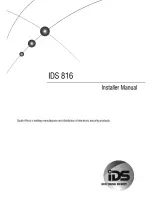
CK 2.2 Keypad
Programming Manual
And
(BKC-DIP) RS232 Guide
Updated 08/13/07
Page 45 of 87
Importing and Exporting Devices continued…
4
In the Available Devices window, select the device you see (it will have the original 5
letter LCD label from the original configuration, rather than the
Manufacturer/Model/Category name you filed it as).
5
Now select an EMPTY position on either MAIN page 1 or MAIN page 2.You cannot
replace an existing device, only an empty spot.
6
Click on the ARROW pointing to the right at the MAIN pages, then click on SAVE.
St
Macro Programming-What is a Macro?
What is a Macro?
A macro is a recording of a sequence of commands that is played back when the user
presses a single button. A macro can have up to 190 steps. A step can be:
IR Command -
Any IR command on any hard button, LCD button on any device. IR
commands in the IR Database are not available to Macros until they have been
programmed into a button somewhere within the configuration.
Delay -
Adjustable delay between steps of .1 and 30 seconds. Using more than one
delay can create longer delays. If a delay is programmed as the first step in a Macro, the
macro will not be issued until the button is pressed and held for the specified amount of
time.
Jump -
As the last step in a Macro, you can specify a jump to any page of any device.
However, an LCD button on MAIN is automatically programmed to jump to the first page
of the device as the first step in a Macro (unless all pages are hidden). You can program
another jump in the macro, so that the automatic jump will happen at the beginning of
the macro and the manually programmed jump will happen at the end of the macro. See
Advanced Programming Tips on page 45 for examples of how you can utilize this
feature.
Can Playback a Macro?
IR Codes
Manufacturers program their products to respond to IR codes with one action or many:
Toggle -
More than one action can occur when the code is sent by a keypad. An
example is a POWER button. The manufacturer programs the TV to respond to a
POWER command by turning it on if it was off and turning off if it was on. So one button
can do two things. This requires that the user “know” or “see” that the television is on or
off before pressing the button.
Another example is a television with an “INPUT” command. When the code is issued,
the television changes its input. Since the television has 5 inputs, the single “INPUT”
command can have
five different results, depending on what input was previously
selected. The user has to “know” or “see” what input was previously selected before
deciding how many times to push the INPUT button.















































